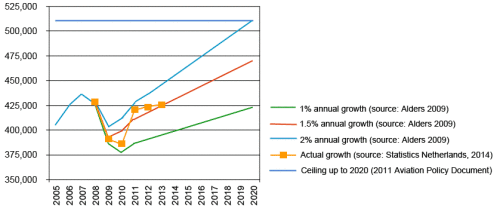As a general rule, every five air transport movements over a full year create one full-time job at the airport. The Dutch government recognises the social, economic and strategic importance of aviation, and it does so, too, when it comes to jobs. This is demonstrated by the Alders Platform Agreement for Amsterdam Airport Schiphol, signed in 2008; the 2009 Aviation Policy Document and its updated edition from 2011, and the 2010 Alders Platform Agreements for Eindhoven Airport and 2012 Lelystad Airport from 2012.
In the 2011 update of its Aviation Policy Document, the Dutch government identified a new growth area for Schiphol, the key elements of which are: the selective growth of Amsterdam Airport Schiphol (510,000 air transport movements) and development of Eindhoven Airport and Lelystad Airport (with a total of 70,000 additional air transport movements per year). The idea is to strengthen Schiphol’s competitive position. The Aviation Policy Document is based on three pillars: competition, the provision of space, and excellent performance by making aviation cleaner, safer and quieter. (Find out more)
The 2009 Alders Committee memorandum “Exploring Market Developments in Aviation up to 2020” outlines the expected growth in the number of air transport movements at Amsterdam Airport Schiphol up to 2020 on the basis of three scenarios.

In the 2009 scenario analysis, the Dutch government begins with a premise of an annual increase in the number of air transport movements of 1%, 1.5% or 2% as of 2012, based on a weak, medium and strong recovery of the economy, respectively.
Currently, actual growth in the number of air transport movements is 1.6%. The growth of Amsterdam Airport Schiphol is expected to continue to increase when the Dutch economy picks up again. (einde meer lezen) BOX:THE SCHIPHOL MASTER PLAN: THE LARGEST CONSTRUCTION PROJECT IN THE NETHERLANDS In order to accommodate the expected growth of Amsterdam Airport Schiphol, the go-ahead was given on 11 July 2013 for the largest construction project in the Netherlands at the present time. The first phase of the Schiphol Master Plan concerns transition to centralised security. Gate checks will be replaced by checks at five locations in the airport (Central Security checkpoints), in order to shorten waiting times for passengers.
The Security checkpoint and the shops in Departure Hall 1 have already been refurbished.
In order to expand Schiphol’s capacity, a new pier, with a capacity of one million passengers per year, will be built at the southern end of the terminal in the next few years.